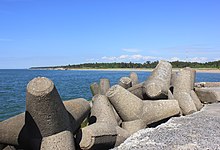20:
34:
93:
244:
69:
156:
68:, invented in 1950. Other proprietary designs include the Modified Cube (United States, 1959), the
150:
65:
23:
8:
175:
163:
19:
33:
224:
220:
169:
144:
81:
37:
Large interlocked Xblocs (8.0 m or 280 cu ft) in a trial placement
73:
238:
98:
89:
211:
Spătaru, A (1990). "Breakwaters for the
Protection of Romanian Beaches".
50:
112:
108:
46:
190:
116:
104:
58:
27:
147: – Human-made underwater structure that functions as a reef
184:
120:
132:
128:
124:
85:
77:
54:
49:
structure designed and employed to minimize the effects of
180:
Pages displaying short descriptions of redirect targets
178: – Surface waves generated by wind on open water
166: – Preventing flooding and erosion of shorelines
236:
172: – Displacement of land along the coastline
157:Breakwater (structure)#Breakwater armour units
53:upon shores and shoreline structures, such as
219:(2). Elsevier Science Publishers: 129–146.
187: – Rock or concrete protective armour
45:is a naturally or manually interlocking
32:
18:
210:
237:
64:One of the earliest designs is the
13:
153: – Coastal defense structure
14:
256:
115:(France, 1981), the Hollow Cube (
245:Wave-dissipating concrete blocks
193: – Form of coastal defence
43:wave-dissipating concrete block
204:
1:
197:
225:10.1016/0378-3839(90)90014-N
127:(The Netherlands, 2001) and
123:(United States, 1998), the
7:
138:
10:
261:
151:Breakwater (structure)
135:, 2010) among others.
38:
30:
107:, 1969), the Seabee (
36:
22:
213:Coastal Engineering
176:Ocean surface wave
164:Coastal management
39:
31:
26:used to protect a
16:Shoreline defense
252:
229:
228:
208:
181:
102:
260:
259:
255:
254:
253:
251:
250:
249:
235:
234:
233:
232:
209:
205:
200:
179:
170:Coastal erosion
145:Artificial reef
141:
96:
82:The Netherlands
17:
12:
11:
5:
258:
248:
247:
231:
230:
202:
201:
199:
196:
195:
194:
188:
182:
173:
167:
161:
160:
159:
148:
140:
137:
74:United Kingdom
15:
9:
6:
4:
3:
2:
257:
246:
243:
242:
240:
226:
222:
218:
214:
207:
203:
192:
189:
186:
183:
177:
174:
171:
168:
165:
162:
158:
155:
154:
152:
149:
146:
143:
142:
136:
134:
130:
126:
122:
119:, 1991), the
118:
114:
111:, 1978), the
110:
106:
100:
95:
92:, 1963), the
91:
87:
84:, 1962), the
83:
79:
76:, 1961), the
75:
71:
67:
62:
60:
56:
52:
48:
44:
35:
29:
25:
21:
216:
212:
206:
90:South Africa
63:
42:
40:
97: [
51:wave action
198:References
94:Stabilopod
113:Accropode
109:Australia
24:Tetrapods
239:Category
139:See also
66:Tetrapod
47:concrete
191:Seawall
117:Germany
105:Romania
59:jetties
28:seawall
185:Riprap
121:A-jack
70:Stabit
133:India
129:KOLOS
125:Xbloc
101:]
86:Dolos
78:Akmon
55:quays
57:and
221:doi
241::
217:14
215:.
99:ro
61:.
41:A
227:.
223::
131:(
103:(
88:(
80:(
72:(
Text is available under the Creative Commons Attribution-ShareAlike License. Additional terms may apply.

